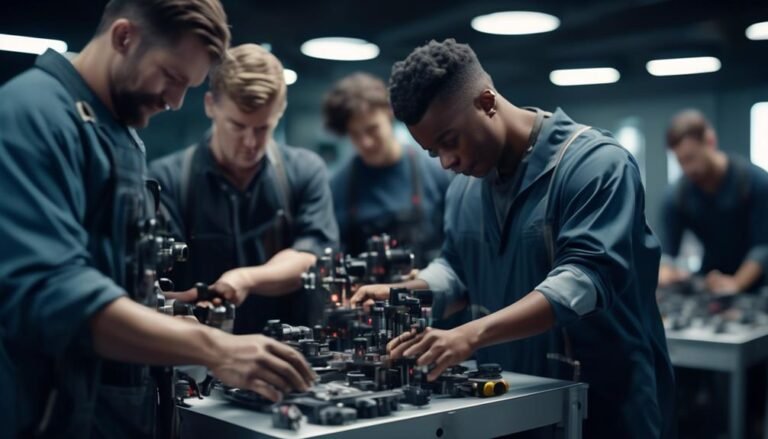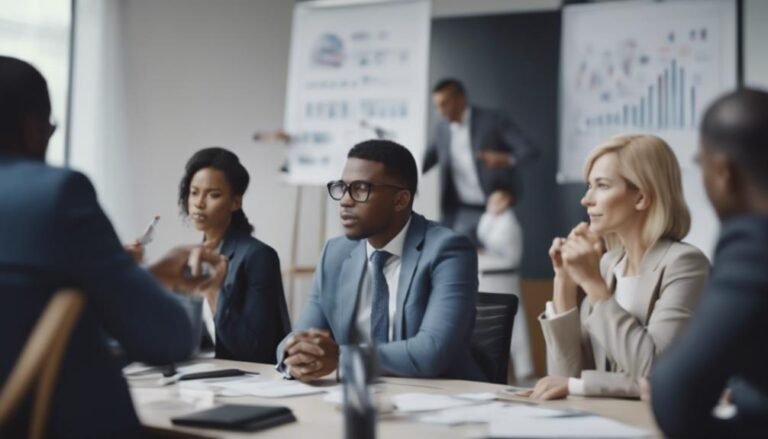Enhancing Team Performance Through Group Training
In today's fast-paced and competitive business environment, organizations are constantly seeking ways to enhance team performance. One effective approach is through group training, which has proven to be a valuable tool for developing and improving the skills of team members.
By providing team members with the necessary knowledge and skills, group training can foster stronger relationships, enhance communication, and promote collaboration and cooperation within the team.
Moreover, it helps to develop leadership skills, encourages innovation and creativity, boosts employee morale and motivation, and ultimately increases productivity and efficiency.
But how exactly does group training achieve all of these outcomes? Let's explore the various ways in which group training can enhance team performance and drive organizational success.
Key Takeaways
- Team training enhances performance, productivity, and motivation.
- Effective communication skills are crucial for minimizing miscommunication and promoting collaboration.
- Developing collaboration and cooperation within the team strengthens relationships and improves communication.
- Leadership skills, innovation, and creativity are essential for creating a collaborative and innovative team environment.
The Importance of Team Training
Team training plays a crucial role in enhancing team performance and productivity. Through team building activities and the benefits of team training, organizations can foster a collaborative and cohesive work environment that promotes effectiveness and success.
Team building activities offer a platform for team members to interact, communicate, and develop strong relationships. These activities can include problem-solving exercises, trust-building exercises, and team challenges. By engaging in such activities, team members can improve their communication skills, build trust, and learn to work together towards common goals. This, in turn, leads to improved teamwork, increased motivation, and enhanced productivity.
One of the key benefits of team training is the development of a shared understanding and common goals. When team members undergo training together, they gain a deeper understanding of each other's strengths, weaknesses, and working styles. This understanding enables them to better coordinate their efforts, leverage each other's skills, and collaborate effectively. Additionally, team training helps to align team members towards a common purpose, ensuring that everyone is working towards the same objectives. This alignment fosters a sense of unity and shared responsibility, resulting in improved team performance.
Building Stronger Relationships
As team members engage in team training activities, they not only enhance their communication skills and collaboration, but also lay the foundation for building stronger relationships within the team. Building trust and fostering camaraderie are essential aspects of developing strong relationships among team members.
Trust is a fundamental component of any successful team. Through group training, team members have the opportunity to work together, learn from each other, and rely on one another. This shared experience creates a sense of trust and reliability within the team. When team members trust each other, they feel more comfortable sharing ideas, taking risks, and seeking support when needed. Trust also enhances team cohesion and reduces conflicts, as team members are more likely to collaborate and support each other's goals.
Fostering camaraderie is another crucial aspect of building stronger relationships within a team. Group training activities provide opportunities for team members to interact, bond, and develop a sense of belonging. By engaging in shared experiences, such as problem-solving exercises or team-building activities, team members can build connections and develop a sense of camaraderie. This camaraderie helps create a positive team culture, where individuals feel valued, respected, and supported by their teammates.
Enhancing Communication Skills
Enhancing communication skills is essential for improving team performance. Clear messages and understanding ensure that team members are on the same page, minimizing miscommunication and confusion.
Additionally, effective listening skills enable team members to fully comprehend and respond to each other, fostering better collaboration and problem-solving.
Clear Messages and Understanding
Effective communication is essential for optimizing team performance and achieving clear messages and understanding. Clear communication allows team members to understand their roles, responsibilities, and expectations, leading to improved collaboration and productivity. To ensure effective messaging, it is important to consider various factors such as the choice of communication channels, the clarity of the message, and active listening.
The following table highlights some key strategies for enhancing clear messages and understanding within a team:
| Communication Strategy | Description |
|---|---|
| Use concise language | Avoid using jargon or complex terms that may confuse team members. Keep messages clear and straightforward. |
| Seek feedback | Encourage team members to provide feedback and ask for clarification when needed. This promotes a culture of open communication and minimizes misunderstandings. |
| Use visual aids | Utilize visual tools such as diagrams, charts, or presentations to enhance understanding and convey complex information effectively. |
| Practice active listening | Actively listen to team members, paraphrase their thoughts, and ask questions for clarification. This demonstrates attentiveness and ensures comprehension. |
| Foster a supportive environment | Create a safe space where team members feel comfortable expressing their ideas and concerns. This builds trust and encourages open and honest communication. |
Effective Listening Skills
Developing strong listening skills is crucial for effective communication and fostering a collaborative team environment. Active listening is an essential aspect of effective communication, as it involves fully focusing on and understanding the speaker's message.
By actively listening, team members can demonstrate their engagement and interest in the conversation, which promotes trust and openness within the team. Effective listening skills also enable team members to accurately interpret information and avoid misunderstandings or misinterpretations.
It involves paying attention to verbal and non-verbal cues, asking clarifying questions, and providing feedback to ensure clear understanding. By practicing active listening, team members can enhance their communication skills, build stronger relationships, and contribute to a more efficient and productive team dynamic.
Improving Collaboration and Cooperation
Improving collaboration and cooperation within a team is essential for achieving optimal performance.
Teamwork techniques such as assigning roles and responsibilities, fostering open communication, and promoting a supportive environment can enhance collaboration.
Additionally, implementing communication strategies such as active listening, effective feedback, and clear goal setting can further improve cooperation among team members.
Teamwork Techniques
Collaboration and cooperation are essential components of successful teamwork, fostering effective communication and synergy among team members. To enhance collaboration and cooperation within a team, the following teamwork techniques can be implemented:
- Team building activities: Engaging in team building exercises can strengthen relationships, build trust, and improve communication among team members. These activities can include icebreakers, trust-building exercises, and problem-solving challenges.
- Clear communication channels: Establishing clear communication channels is crucial for effective teamwork. This includes setting expectations for communication, utilizing technology tools for seamless information sharing, and encouraging open and honest dialogue among team members.
- Problem-solving strategies: Encouraging a problem-solving mindset within the team can enhance collaboration. This involves promoting active participation, brainstorming sessions, and utilizing different perspectives and expertise to find innovative solutions to challenges.
Communication Strategies
To enhance collaboration and cooperation within a team, implementing effective communication strategies is essential. Two key strategies that can improve team communication are providing effective feedback and implementing conflict resolution techniques.
| Communication Strategy | Description |
|---|---|
| Effective Feedback | Providing constructive feedback helps team members understand their strengths and areas for improvement. It should be specific, timely, and focused on behavior rather than personal attributes. This encourages a growth mindset and fosters continuous improvement within the team. |
| Conflict Resolution | Conflict is inevitable in any team, but it can be managed effectively through open and honest communication. Encouraging team members to express their concerns and actively listening to different perspectives helps to find common ground and reach mutually beneficial solutions. Conflict resolution strategies, like compromise and negotiation, can be implemented to ensure conflicts are resolved in a fair and respectful manner.
Developing Leadership Skills
Developing effective leadership skills is crucial for achieving team success and fostering a productive work environment. When it comes to developing leadership potential, there are several key strategies that can be implemented:
- Cultivating effective decision-making: Leaders must possess the ability to make informed and timely decisions. This involves gathering relevant information, analyzing it objectively, and considering the potential impact on the team and organization. By honing their decision-making skills, leaders can navigate complex situations and guide their teams towards successful outcomes.
- Building strong communication skills: Effective leaders are adept at clearly communicating their expectations, goals, and vision to their team members. They actively listen to their team's input and encourage open and honest dialogue. By fostering strong communication, leaders can ensure that everyone is on the same page and working towards a shared objective.
- Encouraging collaboration and teamwork: Leaders need to create an environment that promotes collaboration and teamwork. This involves fostering a culture of trust, respect, and inclusivity, where team members feel comfortable sharing their ideas and working together towards a common goal. By promoting collaboration, leaders can harness the diverse skills and perspectives of their team members, leading to enhanced creativity and problem-solving.
Encouraging Innovation and Creativity
Fostering an environment that nurtures innovation and creativity is essential for organizations seeking to stay competitive in today's rapidly evolving business landscape. Encouraging employees to think outside the box and come up with creative solutions to problems can lead to breakthrough ideas and give companies a competitive edge.
To achieve this, organizations can employ various innovation techniques and promote creative problem-solving.
One effective technique for encouraging innovation is brainstorming sessions. By bringing together individuals from different backgrounds and levels of expertise, organizations can tap into diverse perspectives and generate a wide range of ideas. This collaborative approach fosters creativity and allows for the exploration of unconventional solutions.
Another innovation technique is design thinking. This human-centered approach involves empathizing with users, defining the problem, ideating potential solutions, prototyping, and testing. By focusing on the needs and experiences of end-users, organizations can develop innovative products and services that truly meet customer demands.
Furthermore, organizations can promote creative problem-solving by creating a culture that values experimentation and risk-taking. Encouraging employees to take calculated risks and learn from failures can lead to innovative breakthroughs. Additionally, providing resources and support for employees to develop their creative skills, such as offering training programs or allocating dedicated time for innovation projects, can further enhance a culture of creativity.
Boosting Employee Morale and Motivation
Creating a positive work environment that boosts employee morale and motivation is crucial for organizations looking to foster a culture of productivity and engagement. When employees are motivated and have high morale, they are more likely to be engaged in their work and perform at their best.
Here are three key strategies organizations can use to boost employee morale and motivation:
- Recognition and Rewards: Recognizing and rewarding employees for their hard work and achievements can go a long way in boosting morale and motivation. This can be done through verbal praise, monetary incentives, or non-monetary rewards such as extra time off or opportunities for professional development. By acknowledging and appreciating their contributions, employees feel valued and motivated to continue performing well.
- Open Communication and Feedback: Creating a culture of open communication and providing regular feedback is essential for boosting employee morale and motivation. Employees should feel comfortable expressing their ideas, concerns, and suggestions without fear of retribution. Additionally, providing constructive feedback helps employees understand their strengths and areas for improvement, leading to better performance and increased motivation.
- Work-Life Balance: Encouraging a healthy work-life balance is crucial for employee engagement and performance improvement. Organizations can promote work-life balance by offering flexible work arrangements, providing wellness programs, and promoting a supportive and inclusive culture. When employees have a good balance between their work and personal lives, they are more motivated, energized, and productive.
Increasing Productivity and Efficiency
To optimize team performance, organizations can implement strategies to enhance productivity and efficiency in the workplace. Increasing engagement and optimizing workflow are key factors in achieving these objectives.
One way to increase engagement is by providing clear expectations and feedback to employees. By setting measurable goals and regularly communicating progress, team members are more likely to stay focused and motivated. Additionally, fostering a positive work environment that encourages collaboration and open communication can further enhance engagement.
Optimizing workflow involves streamlining processes and eliminating unnecessary steps. This can be achieved by conducting regular process audits to identify bottlenecks and inefficiencies. By implementing automation and leveraging technology, organizations can reduce manual tasks and improve overall productivity. Encouraging employees to share best practices and providing training on time management and prioritization can also contribute to a more efficient workflow.
Furthermore, effective delegation and task allocation are essential for maximizing productivity. By assigning tasks based on individual strengths and skills, organizations can ensure that work is completed efficiently and effectively. Additionally, providing employees with the necessary resources and tools to perform their tasks can further enhance productivity.
Implementing Effective Group Training Strategies
Effective group training strategies play a crucial role in maximizing team performance and achieving organizational goals. To implement effective group training strategies, organizations can consider the following:
- Encourage group engagement: Group training sessions should encourage active participation and collaboration among team members. This can be achieved by incorporating group discussions, brainstorming sessions, and problem-solving activities. Engaging team members in these interactive exercises fosters a sense of ownership and accountability, leading to increased motivation and commitment.
- Utilize interactive learning techniques: Interactive learning methods, such as simulations, role-playing, and case studies, can make the training experience more engaging and effective. These techniques allow team members to apply their knowledge and skills in a realistic and practical context, enhancing their understanding and retention of the training material.
- Provide continuous feedback and support: Regular feedback is essential in the group training process. Facilitators should offer constructive feedback to individuals and the group as a whole, highlighting areas of improvement and recognizing achievements. Additionally, providing ongoing support, such as coaching and mentoring, can help team members effectively apply their newly acquired skills in their day-to-day work.
Conclusion
In conclusion, group training is a powerful tool for enhancing team performance. By building stronger relationships, enhancing communication skills, and improving collaboration, organizations can create a harmonious and efficient work environment. Developing leadership abilities, encouraging innovation, and boosting morale are also benefits of group training. Additionally, group training can increase productivity and help teams achieve their goals. Through the implementation of effective group training strategies, teams can thrive and reach new heights of success. Embracing the power of group training is like adding a symphony of talent and skills, creating a harmonious rhythm that propels teams towards greatness.







